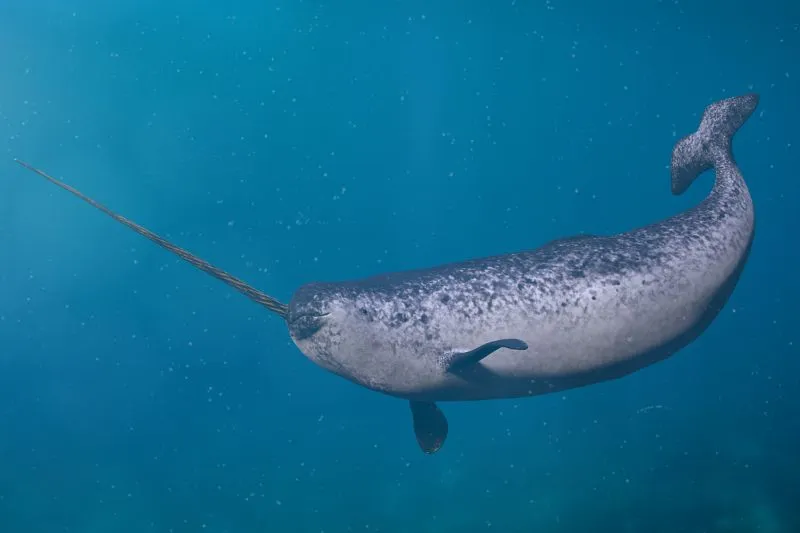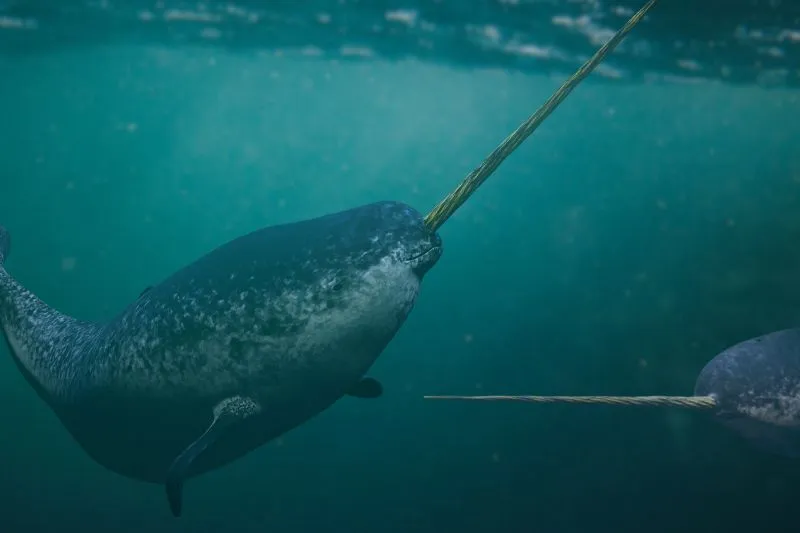Narwhals are easily recognizable and mysterious marine mammals that inhabit the Arctic. You would expect this habitat to be quite barren. Narwhals are large top predators in the Arctic and are highly specialized feeders.
Narwhals are carnivores that eat fish and invertebrates found in the Arctic including Arctic cod, Greenland halibut, squid and shrimp. On average, narwhals eat 16-31 kg (35-68 lb) per day, although this varies between season and location.
Keep on reading to find out more details about the narwhal’s diet and feeding behavior, including how they may use their tusks to capture prey.
What Do Narwhals Eat?
Narwhals are carnivores, so they rely on eating other animals to get the energy to survive. Narwhals tend to eat animals that are smaller than themselves so fish and invertebrates are their main food source.
Typically, narwhals undertake dives to catch their prey1 (source: Wikipedia). Narwhals live in remote areas which has led to them becoming ‘dietary specialists’. This is also because of the way they feed (read more about this later in the article).
The three populations of narwhals around the globe have slightly different diets2 (source: C. A. Watt, et al, Ecosphere, Vol. 4, Issue 6, 2013, pp.1-15). Understanding these differences is important as it can benefit conservation strategies3 (source: J. K. Matley, et al, Polar Research, Vol. 34, 2015). Generally, the most important food sources for narwhals are animals that are found around the bottom of the ocean.
1. Fish
Narwhals eat a variety of fish in different seasons and different locations. One of the main fish species that narwhals eat is the Arctic cod. This is not surprising considering that the Arctic cod is abundant in narwhal’s habitat. The Arctic cod is also an important food source for other marine mammals in the Arctic, including ringed seals and beluga whales4 (source: J. K. Matley, et al, Polar Research, Vol. 34, 2015).
Narwhals also consume the Greenland Halibut and capelin in northeastern Canada. In some instances, the amount of Greenland halibut in the narwhals’ diet has increased5 (source: C. A. Watt & S.H. Ferguson, Marine Mammal Science, Vol. 31, Issue1, 2015, pp.21-44). Narwhals also eat Atlantic redfish, skate eggs, and wolffish6 (source: Wikipedia).
2. Invertebrates
Narwhals eat a variety of invertebrates including squid and shrimp. The importance of invertebrates to the narwhals’ diet varies by location. For example, in Scoresby Sound (a large fjord) in East Greenland, squid was the most frequent animal found in narwhals’ stomachs7 (source: E. Garde, et al, Arctic Science, Vol. 8, No. 2, 2022).

How Do Narwhals Eat?
The feeding behavior of narwhals is highly specialized8 (source: C. A. Watt, et al, Ecosphere, Vol. 4, Issue 6, 2013, pp.1-15).
Generally, Narwhals feed by undertaking dives toward the bottom of the ocean to forage for prey. Narwhals can dive to depths of 1,500 meters (4,920 feet). However, they can also feed near surface waters, as observed in Tremblay Sound, Nunavut9 (source: WWF).
Narwhals feed by using their mouth to create a suction; they need to get close to their prey. Male narwhals have also been known to use their tusk to stun fish. There is a drone-video recording of narwhals tracking cod with their tusk, and then giving the fish a hard tap before suctioning it into their mouth10 (source: Fisheries and Oceans Canada via Youtube). The purpose of this is to make them easier to eat; presumably, so the narwhals spend less energy chasing them11 (source: WWF).
Contrary to what scientists expected, research has found that narwhals feed intensely during the winter, and consume less food during summer12 (source: M.P. Heide-Jørgensen, et al, Animal Biotelemetry, Vol. 2, No. 9, 2014 and K.L. Laidre & M.P. Heide-Jørgensen, Marine Mammal Science, Vol. 21, No. 1, 2005, pp. 45–57).
There are also differences in the narwhal diet between seasons. For example, in winter, narwhals fed on cod and squid. On the contrary, in fall, the narwhal diet consisted exclusively of the Armhook squid.
The narwhal stomach contents changed again in late fall/early winter when Greenland halibut was a main prey item, alongside squid13 (source: K.L. Laidre & M.P. Heide-Jørgensen, Marine Mammal Science, Vol. 21, No. 1, 2005, pp. 45–57).
How Much Do Narwhals Eat?
Narwhals feed around 10 times per day. Each meal has been estimated to be approximately 3.1 kg (6.8 lb) in the winter or 1.6 kg (3.5 lb) in the summer. This means that, on average, narwhals eat 16-31 kg (35-68 lb) each day.
This is a large volume of food compared to most animals. This is because narwhals are large marine mammals with adults averaging around 800 to 1,600 kg (1,760-3,530 lb), therefore need to consume this volume of food to sustain themselves14 (source: Wikipedia).
The amount a narwhal eats may vary by location. For example, in East Greenland where there is smaller prey (squid), narwhals may need to feed more times per day. On the other hand, in Baffin Bay, where larger halibut are common, narwhals may feed fewer times each day15 (source: M.P. Heide-Jørgensen, et al, Animal Biotelemetry, Vol. 2, No. 9, 2014).
How Climate Change is Affecting the Narwhal Diet
Narwhals are associated with ice all year round. Climate change is directly affecting polar regions. This means that there are threats to the habitat that narwhals, and their prey, depend on to survive.
The narwhal’s diet is sensitive to climate change because they have adapted to a very specific polar habitat. However, sea ice decline in response to climate change is a threat to this16 (source: CAFF, Assessment Series No. 10, October 2013), particularly because it can impact the main prey species of narwhals and result in less available food.
The survival of narwhals depends on their ability to adapt to a changing environment; such as climate change. Despite being considered highly specialized feeders, narwhals appear to have responded to these changes over time.
For example, a study has found that between 1962-2010, narwhals changed their diet in response to reduced sea ice cover and increased emissions. Similar findings have been noted with other top predators in the Arctic17 (source: R. Dietz, et al, Current Biology, Vol. 31, Issue 9, 2021, pp. 2012-2019).
What Are the Predators of a Narwhal?
Although narwhals are amongst the top animals of the food chain in the polar region, they still have predators. The main predators of narwhal are orcas, polar bears, and humans18 (source: Wikipedia).
As a result of declining summer sea ice in the Arctic, some predators have higher access to narwhals. This has been observed in orcas and has resulted in a distinct change in narwhal behavior19 (source: G.A. Breed, et al, PNAS, Vol. 114, No. 10, 2017, pp.2628–2633).
Related Questions
Are Narwhals Carnivores?
Yes, Narwhals are carnivores which means that they eat other animals, rather than plants.
Do Narwhals Eat Penguins?
No, narwhals do not eat penguins because they live in different parts of the world. Narwhals live in the northern hemisphere whereas penguins live in the southern hemisphere.
Do Narwhals Eat Seals?
No, narwhals do not typically eat seals.
Do Narwhals Eat Fish?
Yes, narwhals do eat fish. Fish is one of the narwhal’s main prey. The main types of fish that Narwhal eat are Arctic cod, Greenland halibut, and flatfish.
Do Narwhals Eat Polar Bears?
No, narwhals do not typically eat polar bears. Rather, polar bears are one of the main predators of narwhals.
Do Narwhals Eat Krill?
No, narwhals do not typically eat krill or zooplankton. Zooplankton is eaten by polar cod, which are then eaten by narwhals (6). Narwhals do eat other crustaceans including shrimp20 (source: M.P. Heide-Jørgensen, et al, Animal Biotelemetry, Vol. 2, No. 9, 2014).
Do Narwhals Eat Jellyfish?
No, narwhals do not typically eat jellyfish, however, they do eat other invertebrates such as squid.
Do Narwhals Eat Sharks?
No, narwhals do not typically eat sharks. Rather, Greenland sharks are one of the few predators of narwhals.



![Read more about the article Why Narwhals Can’t Live in Captivity [+ Where Can You See Them]](https://polarguidebook.com/wp-content/uploads/2022/10/Narwhal-1-300x200.jpg)
![Read more about the article Where Are Narwhals Found? [+ How To See Them]](https://polarguidebook.com/wp-content/uploads/2022/12/Where-Narwhals-Live-300x200.jpg)
![Read more about the article Why Does a Narwhal Have a Horn? [Unicorns of the Sea Explained]](https://polarguidebook.com/wp-content/uploads/2022/10/Narwhals-Together-300x200.jpg)